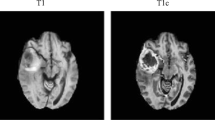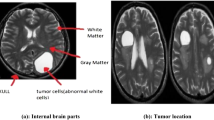Abstract
Astrocytoma is a common type of brain tumor that develops in the glial cells in cerebrum or astrocytes. In a malignant form, it is associated with high mortality. Identifying its grade helps the physicians to think about effective treatment. However, the irregular structure of this tumor type creates difficulty in the identification of its grade. Due to this, medical practitioners suggest additional examinations such as Magnetic Resonance Spectroscopy (MRS) and biopsy for accurate grade identification. In this work, we propose a method to identify astrocytoma grade from brain Magnetic Resonance Imaging (MRI). The proposed method can classify the tumor into low grade and high grade. The segmentation of the brain MRI is performed using spatial fuzzy clustering. We have used intensity, texture, and shape based features for classification. Five classifiers are used for the classification purpose. Our experiment results show that we can achieve an accuracy rate of 92.3% by integrating all three types of features together and applying a suitable classifier.
Access this chapter
Tax calculation will be finalised at checkout
Purchases are for personal use only
Similar content being viewed by others
References
Magnetic resonance imaging. https://www.radiologyinfo.org/
Brain tumor research. https://www.braintumourresearch.org/
Georgiadis, P., Cavourous, D., Kalatzis, I., Daskalakis, A., Kagadis, G.C., Sifaki, K., Malamas, M., Nikiforidis, G., Solomou, E.: Improving brain tumor characterization on MRI by probabilistic neural networks and non-linear transformation of textural features. Comput. Methods Programs Biomed. 89(1), 24–32 (2008)
Sachdeva, J., Kumar, V., Gupta, I., Khandelwal, N., Ahuja, C.K.: Segmentation, feature extraction, and multiclass brain tumor classification. J. Digit. Imaging 26(6), 1141–1150 (2013)
Jyothi, G., Inbrani, H.: Hybrid tolerance rough set-firefly based supervised feature selection for MRI brain tumor image classification. Appl. Soft Comput. 46, 639–651 (2016)
Koley, S., Sadhu, A.K., Mitra, P., Chakraborty, B., Chakraborty, C.: Delineation and diagnosis of brain tumors from post contrast T1-weighted MR images using rough granular computing and random forest. Appl. Soft Comput. 41, 453–465 (2016)
Chung, J., Huang, W., Cao, S., Yang, R., Yang, W., Yun, Z., Wang, Z., Feng, Q.: Enhanced performance of brain tumor classification via tumor region augmentation and partition. PloS one 10(10), e0140381 (2015)
Subashini, M.M., Sahoo, S.K., Sunil, V., Easwaran, E.: A non-invasive methodology for the grade identification of astrocytoma using image processing and artificial intelligence techniques. Expert. Syst. Appl. 43, 186–196 (2016)
Zhao, Z.-X., Lan, K., Xiao, J.-H., Zhang, Y., Xu, P., Jia, L., He, M.: A new method to classify pathologic grades of astrocytomas based on magnetic resonance imaging appearances. Neurol. India 58(5), 685 (2010)
Laha, M., Tripathi, P.C., Bag, S.: A skull stripping from brain MRI using adaptive iterative thresholding and mathematical morphology, In: Proceedings of International Conference on Recent Advances in Information Technology, pp. 1–6 (2018)
Ahmed, M.N., Yamany, S.M., Mohmed, N., Farag, A.A., Moriarty, T.: A modified fuzzy c-means algorithm for bias field estimation and segmentation of MRI data. IEEE Trans. Med. Imaging 21(3), 193–199 (2002)
Torheim, T., Malinen, E., Kvaal, K., Lyng, H., Indahl, U.G., Anderson, E.K.F., Futsæther, C.M.: Classification of dynamic contrast enhanced MR images of cervical cancers using texture analysis and support vector machines. IEEE Trans. Med. Imaging, 33(8), 1648–1656 (2014)
Author information
Authors and Affiliations
Corresponding author
Editor information
Editors and Affiliations
Rights and permissions
Copyright information
© 2020 Springer Nature Singapore Pte Ltd.
About this paper
Cite this paper
Mitra, A., Tripathi, P.C., Bag, S. (2020). Identification of Astrocytoma Grade Using Intensity, Texture, and Shape Based Features. In: Das, K., Bansal, J., Deep, K., Nagar, A., Pathipooranam, P., Naidu, R. (eds) Soft Computing for Problem Solving. Advances in Intelligent Systems and Computing, vol 1048. Springer, Singapore. https://doi.org/10.1007/978-981-15-0035-0_36
Download citation
DOI: https://doi.org/10.1007/978-981-15-0035-0_36
Published:
Publisher Name: Springer, Singapore
Print ISBN: 978-981-15-0034-3
Online ISBN: 978-981-15-0035-0
eBook Packages: Intelligent Technologies and RoboticsIntelligent Technologies and Robotics (R0)




